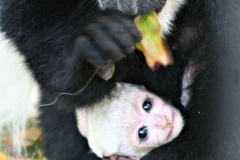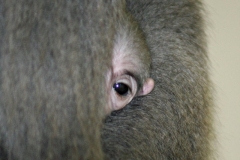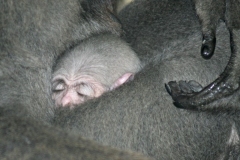
News release from the Fort Wayne Children’s Zoo:
Red Panda Cub Born at Zoo
(June 12, 2014) – A female red panda cub was born at the Fort Wayne Children’s Zoo on June 9 to female Xiao (pronounced JOW), age 4, and her 5-year-old mate, Junjie.
This is the third litter of cubs to be born at the zoo since 1997. Two cubs were born to Xiao in 2012, and a single cub was born in 2013; none of these cubs survived longer than two weeks.
An endangered species, red pandas are difficult to breed and rear in zoos. About half of all cubs die within 30 days of birth. Only a few dozen red panda cubs are born in United States zoos each year.
Contact with Xiao and her cub is extremely limited to improve the cub’s odds of survival. For now, the pathway in front of the red panda exhibit is closed to zoo guests. Keepers monitor the new mother, who spends most of her time in a nest box with the cub, via a remote camera system.
“We are monitoring the cub and are cautiously optimistic at this point,” says Area Manager Shelley Scherer. “But there are still many challenges ahead for this little cub.”
An extensive protocol is in place to monitor the cub while minimizing stress on the mother. Keepers allowed Xiao and her cub complete privacy for the first day, because data show that cubs have a better chance of survival if they are left alone with the mother for the first 24 hours. On Tuesday, keepers quickly weighed the cub while Xiao was out of the nest box feeding; the cub weighed 139 grams. On Wednesday, the veterinary staff performed a brief hands-on health check and determined the cub’s gender.
Daily weigh-ins will continue and supplemental feeding or hand-rearing will be implemented depending on the cub’s progress.
“We always prefer that animals raise their own young, but we are prepared to do all we can to ensure the survival of the cub,” said Animal Curator Mark Weldon. “However, hand-rearing provides no guarantee that the cub will survive.” Weldon noted that hand-reared cubs have a 50-50 chance of survival.
Zoo keepers conducted weekly ultrasounds on Xiao this spring to monitor the cub before birth. Xiao was trained to stand and accept the ultrasound, during which she was rewarded with a food treat. Her diet, which includes commercially-produced chow and fresh bamboo, was altered to provide additional nutrition during her pregnancy. Keepers also installed a second air-conditioned nest box in the exhibit to give Xiao comfortable options for nesting.
Tests revealed that cub born to Xiao in 2013, which survived for only three days, never ingested any milk, though the reason for this is not known. That cub was scheduled to undergo a complete physical on the day it died.
Mary Noell of the Cincinnati Zoo serves as North American Regional Studbook Keeper for red pandas and maintains data on all red pandas in United States and Canadian zoos. “This is not an unusual situation,” she said last year after the cub died. Noell visited the Fort Wayne Children’s Zoo in 2013 and noted that the zoo’s facilities and protocols met all current standards for red panda care.
Red panda cubs are born blind and deaf. The mother spends nearly all her time nursing and grooming her cubs during the first week. The cubs remain in the nest until they are about three months old. Little is known about red panda cub mortality in the wild.
“If the cub survives, zoo guests are unlikely to see it outside of the nest box until sometime in August or September,” said Scherer. Until then, the zoo will post updates on its website and social media accounts.
The breeding of red pandas is overseen by the Species Survival Plan (SSP), a program of the Association of Zoos & Aquariums (AZA). The goal of the SSP is to maximize genetic diversity in captive populations of endangered animals.
Red pandas are native to the forested foothills of the Himalaya Mountains in China and Nepal, where they feed primarily on bamboo. Though they share a name with the famed black-and-white giant pandas, the two are not closely related. The name “panda” comes from the Nepalese word ponya, which means “bamboo-eater.”
About the Fort Wayne Children’s Zoo
The Fort Wayne Children’s Zoo is northeast Indiana’s largest tourist attraction, hosting more than 500,000 guests annually. The zoo was voted Indiana’s #1 “Gotta-Do Summer Attraction” and is consistently named one of the nation’s Top Ten Zoos for Kids by national media outlets.The zoo is a conservation leader, contributing more than $80,000 annually to local, regional, and international efforts to protect wild animals and habitats, and participating in cooperative management programs for 15 endangered species.
As a self-supporting facility, the Fort Wayne Children’s Zoo receives no tax dollars for operations. The zoo’s operations are funded entirely by earned revenue and donations.
The zoo is open 9:00 AM – 5:00 PM daily through October 12, 2014. Admission is $14.00 for adults; $10.50 for seniors age 60+; and $9.00 for children ages 2-18. Babies age 1 and under and Zoo Society Members are admitted free.















